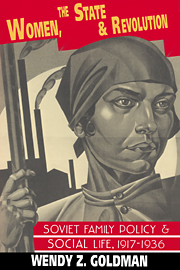Book contents
- Frontmatter
- Contents
- List of tables
- Acknowledgments
- 1 The origins of the Bolshevik vision: Love unfettered, women free
- 2 The first retreat: Besprizornost' and socialized child rearing
- 3 Law and life collide: Free union and the wage-earning population
- 4 Stirring the sea of peasant stagnation
- 5 Pruning the “bourgeois thicket”: Drafting a new Family Code
- 6 Sexual freedom or social chaos: The debate on the 1926 Code
- 7 Controlling reproduction: Women versus the state
- 8 Recasting the vision: The resurrection of the family
- Conclusion: Stalin's oxymorons: Socialist state, law, and family
- Index
- Soviet and East European Studies
2 - The first retreat: Besprizornost' and socialized child rearing
Published online by Cambridge University Press: 26 March 2010
- Frontmatter
- Contents
- List of tables
- Acknowledgments
- 1 The origins of the Bolshevik vision: Love unfettered, women free
- 2 The first retreat: Besprizornost' and socialized child rearing
- 3 Law and life collide: Free union and the wage-earning population
- 4 Stirring the sea of peasant stagnation
- 5 Pruning the “bourgeois thicket”: Drafting a new Family Code
- 6 Sexual freedom or social chaos: The debate on the 1926 Code
- 7 Controlling reproduction: Women versus the state
- 8 Recasting the vision: The resurrection of the family
- Conclusion: Stalin's oxymorons: Socialist state, law, and family
- Index
- Soviet and East European Studies
Summary
In March 1921, an organizer for the Detkomissiia (Commission for the Betterment of the Life of Children), traveled south from Moscow into a famine-stricken area. Deeply shaken by what he saw, he wrote in his report:
Our train arrived at night and stopped not far from Samara. For some reason we could not go any farther. It was one or two in the morning. It was quiet and there was frost on the beets. Our train slept, all was silent, but suddenly, I could make out a thin, weak, remote wailing. I listened – the wailing grew strong and then fell again. I went out onto the platform. In the moonlight, at a great distance, lay some kind of gray rags. As I looked I could see them turning, and from the bosom of these rags came a weak, lingering wail: “Kh-le-b-tsa-, kh-le-b-tsa.” One could scarcely distinguish the separate voices, but due to their faintness, they all merged in a weak drawn-out wail. They were children, perhaps three, maybe four thousand, and at my disposal I had ten pounds of bread.
By 1922 there were an estimated 7.5 million “starving and dying” children in Russia. Many, having lost one or both parents, fled broken families and desolate villages, and descended on the towns in search of food. Known as the besprizorniki (homeless waifs), they traveled alone and in bands, illegally riding the rails from one end of the country to another. They gathered in shifting crowds in the railroad stations and marketplaces, stealing, begging, picking pockets, and prostituting themselves to survive.
- Type
- Chapter
- Information
- Women, the State and RevolutionSoviet Family Policy and Social Life, 1917–1936, pp. 59 - 100Publisher: Cambridge University PressPrint publication year: 1993



